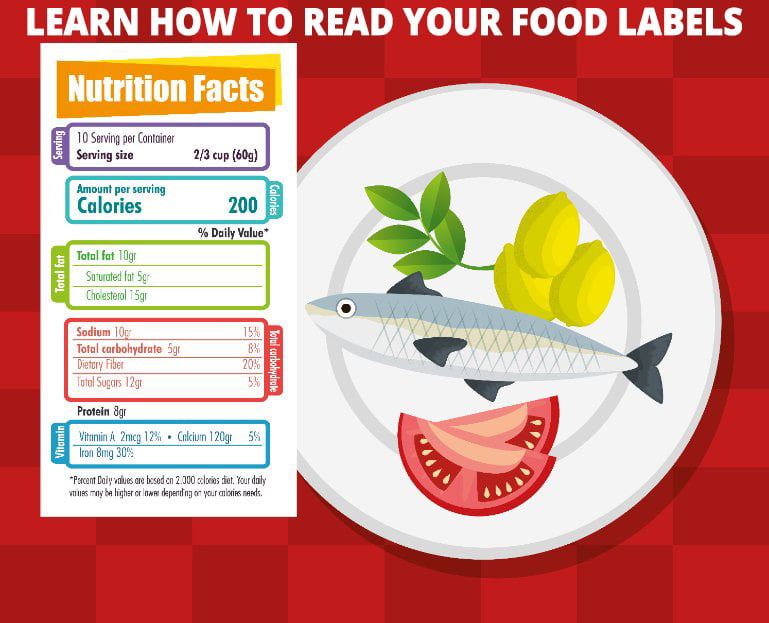Even our government has its own recommendations: the food plate (which used to be a pyramid) and the all-confusing food labels. While I think these food labels only add to the food confusion, they can provide some useful information, and I want to show you what you are actually looking at.
Every food label provides facts about some key nutrients present in that product.
 To start, a food label provides information about the food items contained within a package. The first thing listed on the label is the amount of food item per container and then the amount of nutrients per single serving. The serving size is set as a typical serving of that food item and is reported in both standard (cups) and in metric (grams) measurements. When interpreting a food label, the serving size is extremely important. The serving size is set as a reference point for understanding the rest of the label and is not necessarily a recommendation on how much you should eat. Unless you actually measure and weigh your food, it is nearly impossible to know how much of an item you are actually eating, and then you cannot benefit from the nutrient information listed on that label.
To start, a food label provides information about the food items contained within a package. The first thing listed on the label is the amount of food item per container and then the amount of nutrients per single serving. The serving size is set as a typical serving of that food item and is reported in both standard (cups) and in metric (grams) measurements. When interpreting a food label, the serving size is extremely important. The serving size is set as a reference point for understanding the rest of the label and is not necessarily a recommendation on how much you should eat. Unless you actually measure and weigh your food, it is nearly impossible to know how much of an item you are actually eating, and then you cannot benefit from the nutrient information listed on that label.
The items listed on a nutrition label are shown in gram measurements and % daily values, again in reference to the listed serving size and based on the assumption that you are eating 2000 calories a day. A nutrition label is required to list, per serving, the total calories, total fat, cholesterol, total carbohydrates, sodium, and protein that are contained in a single serving of an item. We also get information about total sugar and added sugar.
Added sugar refers to sugars that are not naturally occurring in the food (like lactose in milk, for example), but are added in for extra sweetness.
Most of us don’t have any clue how many grams of fat, cholesterol, sodium, or protein we should eat in a day, and also don’t know how many calories we typically eat in a day, so it is difficult to know how that food item is adding up in your daily intake and nutritional needs. People often ask me how much of a certain nutrient they should try to eat, and I think this just makes a confusing issue even more confusing.
I typically find that the nutrition labels tend to be confusing and do not change the eating habits of the average person. Referring to the nutrition label tells us nothing about the product in the package. You cannot even tell what the food is and whether or not it is good for you.

Instead of concerning yourself with the nutrition label, I encourage you to read the actual ingredient list on the package. The FDA requires the ingredients to be listed, in order by weight, from heaviest to lightest. Hopefully this list will include things that you know and understand, but will also include preservatives, food dyes, thickeners and emulsifiers, added sugars, and the chemical names of vitamins and minerals.
Here is where label reading comes in handy, and you can start to avoid food confusion. If you are looking at the ingredient list, I recommend that you clearly know what each ingredient is.
If there are items on the list that you don’t know, it is probably not something that you should put in your mouth.
Foods that have labels are often foods that are manufactured and are not fresh foods. These products are created by food scientists to be highly palatable so that you want to eat more of it. There is no regard for nutritional value, and no regard at all for your personal health.
My aim is to help you eat whole foods. Because there are so many diets that have shown to be beneficial and no one seems to be able to agree on the best one, sticking to whole foods is an easy way to ensure that you are eating a healthy diet. These are foods that have grown, that have not been altered from their original form, and that have only one ingredient : ITSELF.
The best way, then, to ensure that you are eating a healthy diet is for you to avoid “foods” that have a nutritional label. If they do have a nutritional label on them, the ingredient list should only have whole foods listed.
Examples of whole foods include: animal proteins (beef, pork, chicken, eggs, turkey, etc.), vegetables, fruits, raw or dry roasted nuts and seeds, milk and cheeses, yogurts and kefir (plain and unsweetened), butter, ghee, olive, avocado and coconut oils, beans (dry or canned with nothing added), and whole grains (plain rice, oats, quinoa).
Give me a call and let’s start working together to help you with your nutrition and overall health.
www.drklearman.com
Instagram @lizaklear
Facebook @drelizaklearman
Empowering Active People to Achieve Optimal Health Using Natural, Drug-free Solutions
www.vailvalleypharmacy.com
Facebook @vailvalleypharmacy
More Than Just a Pharmacy
If you need help and guidance in your journey to better health, schedule your appointment today!
Call me at 970-328-5678. to book your appointment today!




